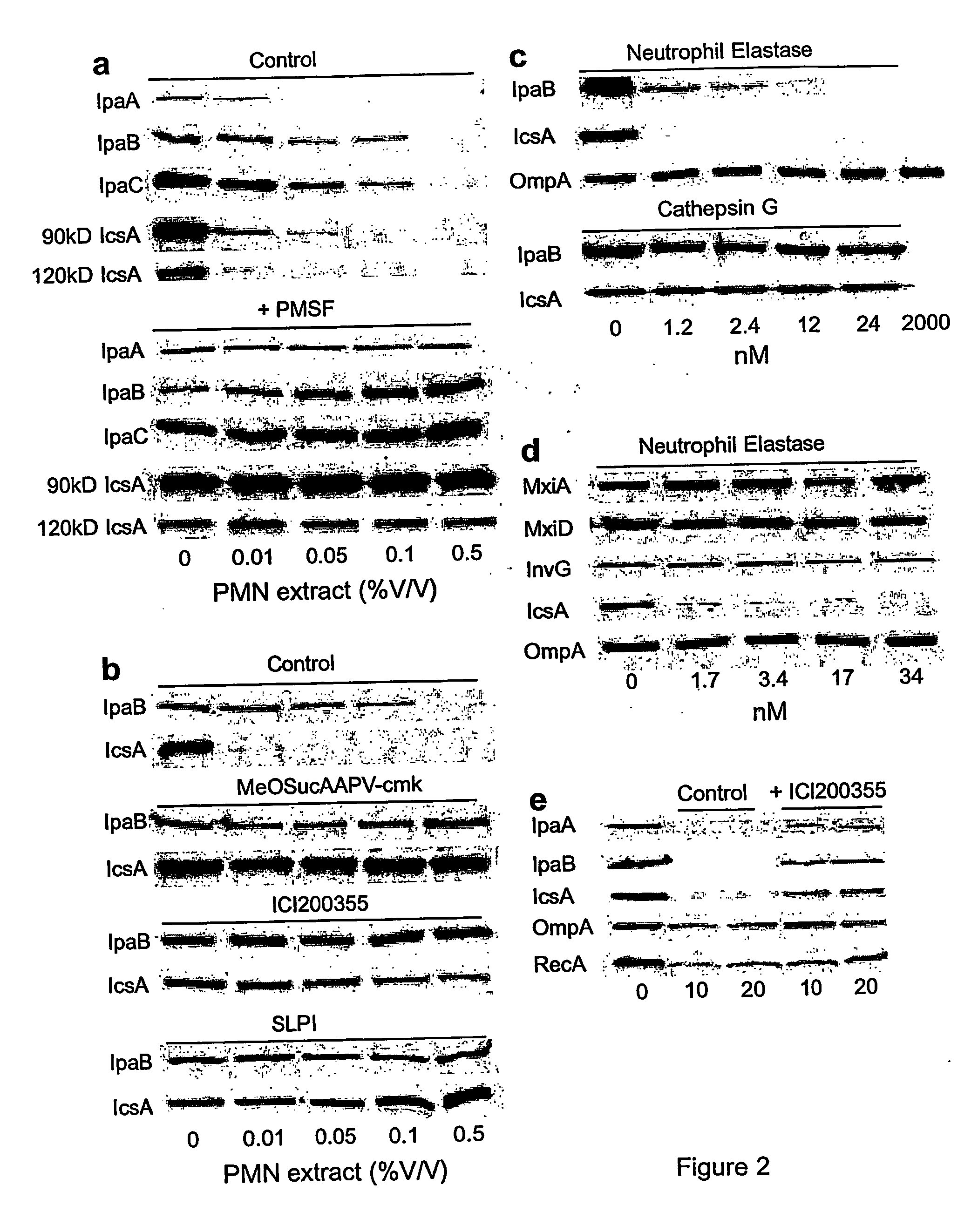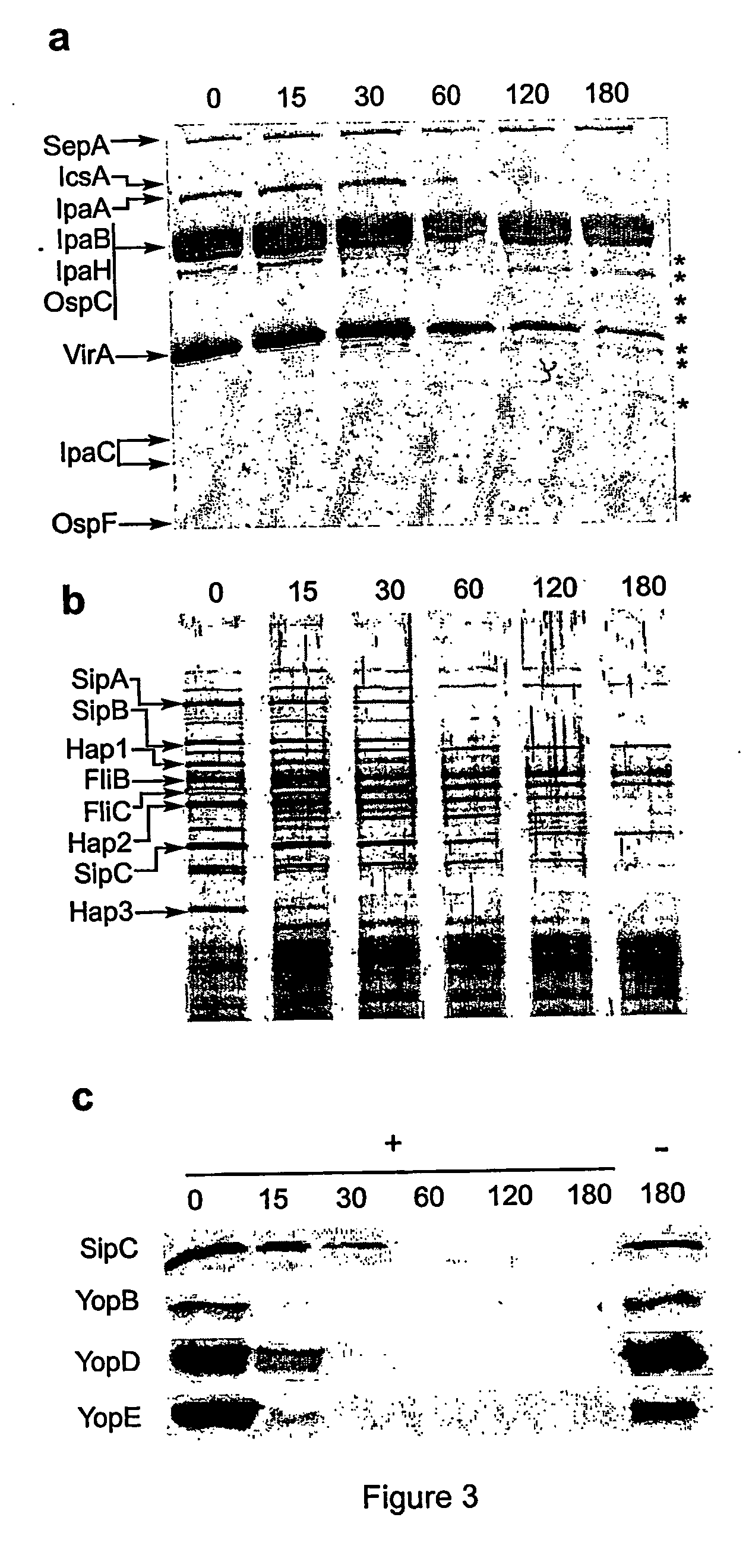Treatment of bacterial infection with elastase
a technology of elastase and bacterial infection, which is applied in the direction of peptide/protein ingredients, pharmaceutical active ingredients, and the field of treatment of bacterial infection with elastase, can solve the problems of long hospital stay of infected patients, high health care costs, and high resistance to antimicrobial resistance, and achieve the effect of degrading bacterial virulence factors and high specificity
- Summary
- Abstract
- Description
- Claims
- Application Information
AI Technical Summary
Benefits of technology
Problems solved by technology
Method used
Image
Examples
example 1
Bacterial Strains and Growth Conditions
[0035] M90T, an invasive isolate of S. flexneri serotype 5, BS176, the noninvasive derivative of M90T and the Shigella ipaD mutant (Menard et al., “Nonpolar Mutagenesis of the ipa Genes Defines IpaB, IpaC, and IpaD as Effectors of Shigella Flexneri Entry into Epithelial Cells,”J Bacteriol 175:5899-5906 (1993), which is hereby incorporated by reference), which constitutively secretes the Ipa proteins was grown to the exponential phase of growth in tryptic soy broth (TSB) with aeration. S. typhimurium, strain SL1344, was grown overnight in LB medium at 37° C. without agitation and Y. enterocolitica (strain W22703), was grown at room temperature to an optical density at OD 600 nm of 0.4 in TSB supplemented with 5 mM EGTA and 20 mM MgCl2. The bacteria were centrifuged and the cell pellet resuspended in nutrient broth supplemented with phosphate-buffered (20 mm, pH 7.4) physiological saline (108 CFU / ml) and cultures shifted to 37° C. for 2 h.
example 2
Bactericidal Activity
[0036] Bactericidal activity of hNEGP prepared as described in (Weiss et al., “Purification and Characterization of a Potent Bactericidal and Membrane Active Protein from the Granules of Human Polymorphonucelar Leukoytes,”J. Biol. Chem 253:2664-2672 (1978), which is hereby incorporated by reference) was quantified with wild-type strain M90T. Briefly 108 bacteria were incubated in a total volume of 1 ml for 30 min at 37° C. with shaking as described (Mandic-Mulec et al., “Shigella Flexneri is Trapped in Polymorphonuclear Leukocyte Vacuoles and Efficiently Killed,”Infect Immun 65:110-115 (1997), which is hereby incorporated by reference). After aliquots were removed for determination of colony forming units (CFU), the sample was centrifuged (5 min at 14,000 g). Supernatants were filtered through a 0.2 μm pore-size filter and recovered proteins were precipitated with methanol / chloroform (Lee et al., “Type III Machines of Pathogenic Yersiniae Secrete Virulence Fact...
example 3
Protein Preparation and Immunoblot Analysis
[0037] Protein from bacterial pellets (2.5×107 cell equivalent) and culture supernatants (1 ml) were subjected to SDS-polyacrylamide gel (12.5%) electrophoresis (SDS-PAGE). The protein bands separated by SDS-PAGE were transferred to a nitrocellulose membrane and detected using antibodies specific for IpaA, IpaB, IpaC, and IcsA. Alternatively, secreted proteins (30 μg) from culture supernatants from the indicated strains were filtered after separation by centrifugation of bacterial cultures and treated with 3.4 nM neutrophil elastase after which the reactions were stopped with the addition of PMSF (1 mM) at the indicated times. Proteins were then precipitated as described above, resolved by SDS-PAGE, and stained with Coomassie blue or silver nitrate or subjected to immunoblot analysis with SipC, or YopB, YopD, and YopE antisera. Immunoblotting for type III components were detected in bacterial pellets with anti-MxiD, InvG, and LcrD antibodi...
PUM
| Property | Measurement | Unit |
|---|---|---|
| optical density | aaaaa | aaaaa |
| pH | aaaaa | aaaaa |
| volume | aaaaa | aaaaa |
Abstract
Description
Claims
Application Information
 Login to View More
Login to View More - R&D
- Intellectual Property
- Life Sciences
- Materials
- Tech Scout
- Unparalleled Data Quality
- Higher Quality Content
- 60% Fewer Hallucinations
Browse by: Latest US Patents, China's latest patents, Technical Efficacy Thesaurus, Application Domain, Technology Topic, Popular Technical Reports.
© 2025 PatSnap. All rights reserved.Legal|Privacy policy|Modern Slavery Act Transparency Statement|Sitemap|About US| Contact US: help@patsnap.com



